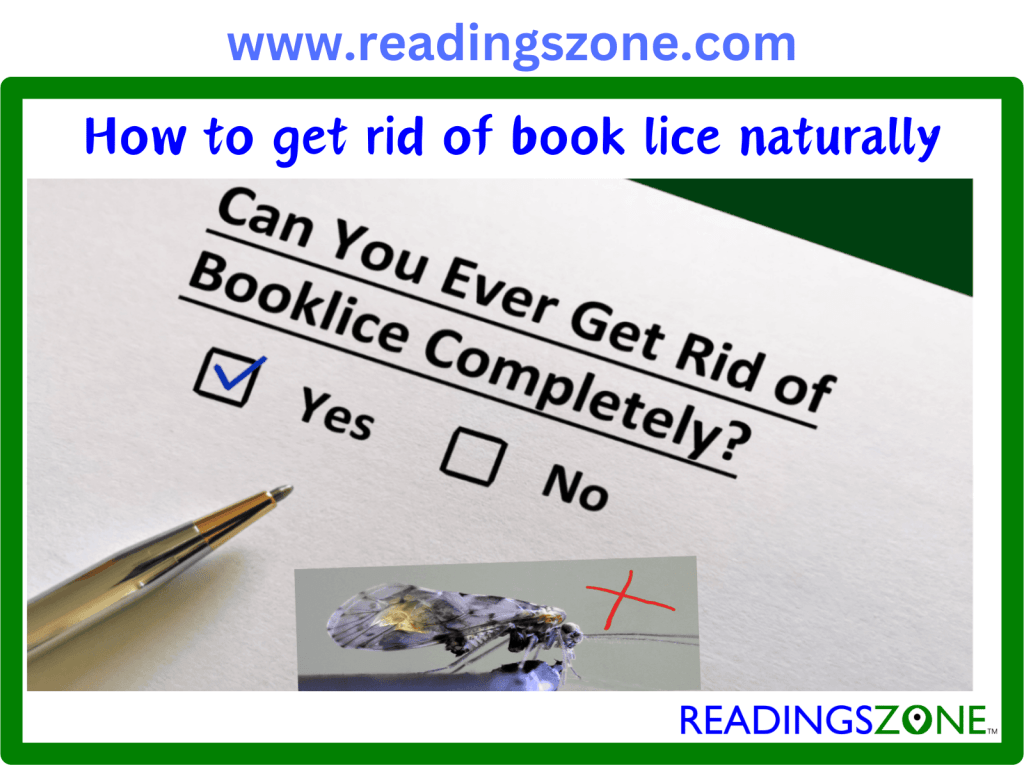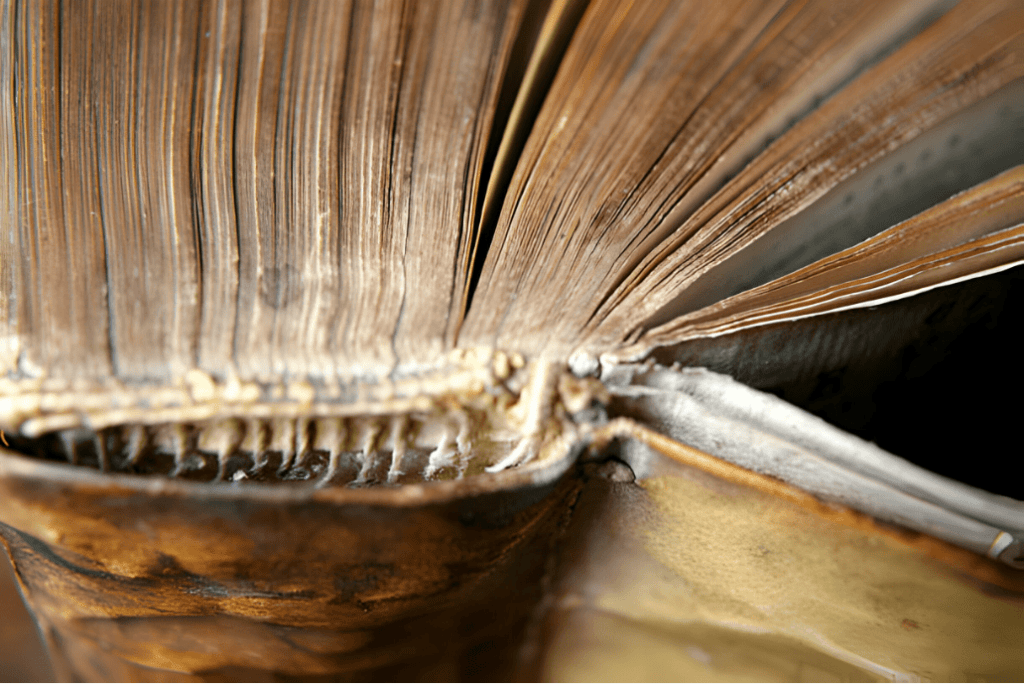How to get rid of booklice naturally & other best ways[Complete Guide]

Have you ever seen little bugs moving on the walls or in your books? Most likely, you’ve witnessed booklice, also known as Psocoptera. These little animals love to hang out in wet, sticky places. You may wonder why you should use natural methods to eliminate them. Simple: it’s better for you and the world around you. Now, let’s learn about booklice and how to get rid of psocids properly.
Table of Contents
Toggle
How to get rid of booklice (also known as psocids) primarily focuses on eliminating their food source (mold and mildew) and the high humidity they need to survive.
Further explore the detailed guide on how to take care of library books in a detailed way
Section 1: Understanding Booklice
What Is Booklice?
The booklice are very small, almost microscopic bugs. They are usually pale, don’t have wings, and are less than 1/16 inch across. But don’t be fooled by their small size; they can be a real pain. These little guys do best in damp places and love eating mold or things high in starch.
Their Favorite Hangouts
Your home is like a luxury resort for booklice. They love places like cereal boxes, wet books, and wallpaper glue. People also get sick in offices, especially with a lot of paper and bad airflow.
Booklice vs. Other Pests
Mixing booklice with other pests is easy, but they’re unique. Unlike bed bugs or termites, they don’t bite or cause structural damage. They’re more of an annoyance than a danger.
Comparison table on booklice vs. other pests
| Feature | Booklice | Other Common Pests (e.g., Bed Bugs, Termites) |
| Size | Typically, less than 1/16 inch | Varies, often more significant than booklice |
| Appearance | Pale, wingless, soft-bodied | Varied; usually darker, some have wings |
| Biting Humans | Do not bite | Some do (e.g., bed bugs) |
| Diet | Mold, fungi, starchy materials | Varies (wood for termites, blood for bed bugs) |
| Habitat | Prefers humid environments | Varies; often in beds, furniture, wood structures |
| Health Risk | Minimal; more of a nuisance | Can be significant (allergies, structural damage) |
| Sign of Presence | Usually in damp, moldy areas | Signs vary (bite marks, wood damage, droppings) |
| Control Measures | Humidity control, cleanliness | Often require specific treatments (chemical, heat) |
Section 2: 1o Leading Causes of Booklice Infestation
Why did Booklice decide to move in? Two main culprits are high humidity and organic materials. Cluttered, poorly ventilated areas also roll out the red carpet for these pests. So, keeping things airy and tidy is your first line of defence. These ten points are crucial.
- Booklice can grow very well in places with a lot of wetness.
2. Booklice like damp places like basements and closets that don’t have enough airflow.
3. Mould and mushrooms, which grow in damp places, are what booklice eat.
4. Booklice can get into books and paper stored in damp places.
5. Booklice like living in walls and ceilings with leaks or condensation.
6. Accumulating organic debris, such as old books and newspapers, invites booklice.
7. Bookcases that are too crowded and don’t allow enough airflow can harbor booklice.
8. If you can’t control the humidity in storage places like attics, booklice will grow there.
9. Booklice gets into homes that aren’t cleaned and dusted often enough.
10. Booklice often appear because of poor insulation, which lets water in and makes the wood wet.
Section 3: Identifying Booklice Infestation & Getting Out of it
Spotting the Intruders
Finding booklice is a bit like a detective game. Look out for tiny bugs in damp areas, or even better, use a magnifying glass. They love the spine of books and crevices on walls.
Confirming Their Presence
Use a transparent tape trap if you suspect a booklice party in your home. Stick it in suspected areas and check if any tiny pests get caught.
How to get rid of booklice in books: 6 Great ways

Pic credit: Shutterstock
Getting rid of booklice in books requires a few careful steps to keep the books in good shape while getting rid of the bugs. Here’s our step-by-step guide on how to get rid of book mites properly.
a. Identify the Problem
Booklice thrive in warm, humid environments (ideally 75–82°F and 75–90% relative humidity) because they feed on the microscopic mold and mildew that grow in these conditions.
Improve Airflow: Open windows when possible and move furniture and bookshelves away from walls to allow air to circulate.
- Look for Signs: Booklice are tiny insects often found in areas with high humidity. Look for minor, pale bugs in your books.
- Check for Damage: They may leave behind tiny feces or cause mild damage to the paper.
b. Isolate Affected Books
Separate Infested Books: To prevent the spread of booklice, isolate the infested books from your collection.
c. Reduce Humidity
This is the most critical step. Aim to keep the relative humidity in your home below 50%, and ideally between 30–50%. Booklice will die off within 2–3 weeks in a dry environment.
-
- Use a dehumidifier in damp areas like basements, attics, and storage rooms.
- Run your air conditioner or fans to circulate air.
- Ensure proper ventilation in bathrooms and kitchens (run exhaust fans after showering/cooking).
- Fix any leaking pipes or sources of standing water immediately.
- Use a dehumidifier in damp areas like basements, attics, and storage rooms.
- Ventilate: Open windows when possible and move furniture and bookshelves away from walls to allow air to circulate.
d.Eliminate Food Sources and Clean
Remove Mold and Mildew: Since mold is their food, cleaning it up is essential.
-
- Use an anti-fungal cleaner, a diluted borax solution (1 cup borax to 1 gallon of warm water), or vinegar to scrub down affected surfaces.
- Discard heavily molded items like old newspapers, cardboard boxes, or books that cannot be cleaned.
Deep Clean and Vacuum:
-
- Use a vacuum with a crevice tool to thoroughly clean bookshelves, cracks, crevices, behind furniture, and inside cabinets/pantries.
- Wipe down all shelving, especially in the kitchen and pantry.
Store Food Properly: Keep grains, flour, cereals, and other dry goods in airtight plastic or glass containers instead of original bags or cardboard boxes.
e. Clean the Books
- Gentle Cleaning: Use a soft brush to remove any visible booklice and debris from the pages and covers.
- Avoid Water or Chemicals: Do not use water or harsh chemicals as they can damage the books.
f. Freeze the Books
- Use Freezing Method: Freeze books in a plastic bag for a few days. This will kill any remaining booklice.
- Slow Thawing: Allow the books to thaw gradually to prevent condensation after freezing.
g. Maintain a Dry Environment
- Regular Monitoring: Monitor the humidity levels and inspect books regularly for any signs of booklice.
- Proper Storage: Store books in a dry, cool place. Avoid storing them in basements or attics where humidity can be high.
Section 4: How do you get rid of booklice on the wall: Step-by-step guide
To get rid of booklice on the wall, almost the same stories are considered as we mentioned earlier.
a.Identify the Infestation:
- Look for tiny, light-colored insects on walls, especially in damp and moldy areas.
- Booklice are often found where there is mold, as they feed on it.
b.Reduce Humidity:
- Use a dehumidifier to reduce the moisture level in your home. Booklice thrives in humid conditions.
- Ensure good air circulation by opening windows and using fans.
- Fix any leaks or dampness issues in your home.
c.Clean the Infested Areas:
- Wipe down walls and surfaces with a mild detergent and water solution.
- Avoid using too much water, as additional moisture can exacerbate the problem.
d.Remove Mold:
- Clean moldy areas thoroughly, as booklice feed on mold.
- Use a mixture of water and vinegar or a commercial mold remover, following the instructions carefully.
e.Vacuum Regularly:
- Vacuum walls, floors, and crevices to remove any booklice and eggs.
- Empty the vacuum bag outside immediately after cleaning to prevent re-infestation.
f.Inspect and Clean Books and Paper Products:
- Papers and cardboard infestations, which can harbour booklice.
- Store paper products in dry, airtight containers if possible.
g.Use Insecticides if Necessary:
- tation is severe, consider using an insecticide designed explicitly for booklice.
- Always follow the product’s instructions and precautions.
h.Prevent Future Infestations:
- Maintain low humidity levels in your home.
- Regularly inspect and clean walls and storage areas to catch any new infestations early.
Alternative ways to get rid of booklice
Desiccants:
Your Secret Weapon. Diatomaceous earth is like a kryptonite for booklice. Sprinkle it around their hangouts, and it’ll dehydrate them.
Using Desiccants (Natural Solutions)
Desiccants kill booklice by drying them out, which is effective given their high dependence on moisture.
- Diatomaceous Earth (DE): Use food-grade diatomaceous earth (a fine, powdery dust).
- Lightly sprinkle it in dry areas where booklice are found (behind bookshelves, along baseboards, in cracks/crevices).
- Do not apply to wet areas, as it becomes ineffective. It usually takes 1-2 weeks to work. Vacuum and reapply as needed.
Essential Oils to Kill Booklice:
Nature’s Insecticide. Certain oils, like peppermint or neem oil, can deter booklice. Just mix with water and spray lightly in affected areas. Remember, a little goes a long way!
DIY Traps and Barriers
Creating barriers with talcum powder or setting up sticky traps can catch these pests off guard.
Section 5: Cleaning Strategies
The Battle Plan
Cleaning is your best strategy. Vacuum thoroughly and wipe down surfaces with vinegar or a mild detergent. Focus on bookshelves, wall crevices, and other favorite spots.
Natural Cleaning Agents
Use natural agents like vinegar or baking soda solutions. They’re practical and safe for your books and walls.
Section 6: Controlling Humidity and Ventilation
Reducing humidity is crucial. Aim for below 50% if possible. Good ventilation is key, so open those windows or use a dehumidifier. Air purifiers can also help reduce overall dampness.
Section 7: Preventive Measures
a.Regular Cleaning
Make cleaning a habit. Dust and vacuum regularly to keep booklice at bay.
b.Smart Storage
Store your books and papers in dry, well-ventilated areas. Consider using airtight containers for extra protection.
c. Humidity Monitoring
Keep an eye on humidity levels. A simple hygrometer can help you stay on top of this.
Prevent Future Infestations
- Regular Cleaning: Dust and clean your bookshelves and books regularly.
- Monitor Humidity: Keep an eye on the environmental conditions in your storage area to prevent future infestations.
- Remember, the key to dealing with booklice is to create an unfavorable environment for them, primarily by reducing humidity and maintaining a clean, dry space for your books.
Section 8: When to Seek Professional Help
Sometimes, despite your best efforts, booklice persists. If you’re overwhelmed, it might be time to call in the pros. They can offer more potent solutions and peace of mind.
Consult wita h professional
Seek Expert Advice: If the booklice problem is severe or involves valuable or antique books, it’s advisable to consult a conservation expert for proper treatment.
Conclusion
Getting rid of booklice naturally is about maintaining a clean, dry environment. With the right cleaning strategies, natural remedies, and preventive measures, you can say goodbye to these pesky intruders. Remember, it’s about being persistent and proactive! That’s our complete thoughts & findings in the query of booklice how to get rid of them.
Frequently Asked Questions
Q. 1 How Do I Get Rid of Booklice on Walls?
Ans. To tackle booklice on walls, start by reducing humidity and using a mixture of water and essential oils like neem or peppermint. Gently spray the mixture on the walls, focusing on the infested areas.
Q.2.Can Booklice Damage My Books?
Ans. While booklice don’t eat paper, their presence and the humidity they thrive in can damage the pages and bindings of books. Keeping your books dry and well-ventilated is vital.
Q.3. Are there Any Specific Essential Oils That Work Best Against Booklice?
Ans. Peppermint, neem, and eucalyptus oils are known to be effective against booklice. They act as natural deterrents and are safe to use around the house.
Q.4.What Should I Do If Natural Remedies Don’t Work?
Ans. It might be time to consult a professional pest control service if natural remedies fail. They can provide more potent solutions to manage the infestation effectively.
Q. 5. Is Using Desiccants Like Diatomaceous Earth Around Pets and Children Safe?
Ans. When used correctly, diatomaceous earth is generally safe around pets and children. Just be sure to follow the instructions and use food-grade diatomaceous soil.
Remember, the key to getting rid of booklice naturally is persistence and maintaining a clean, dry environment. Good luck!


